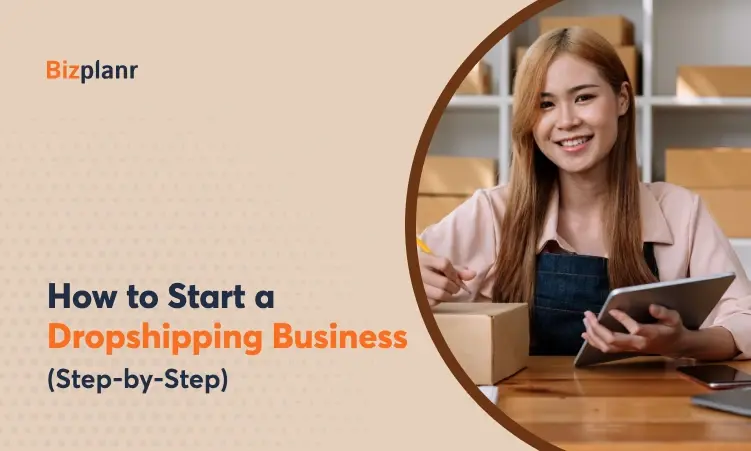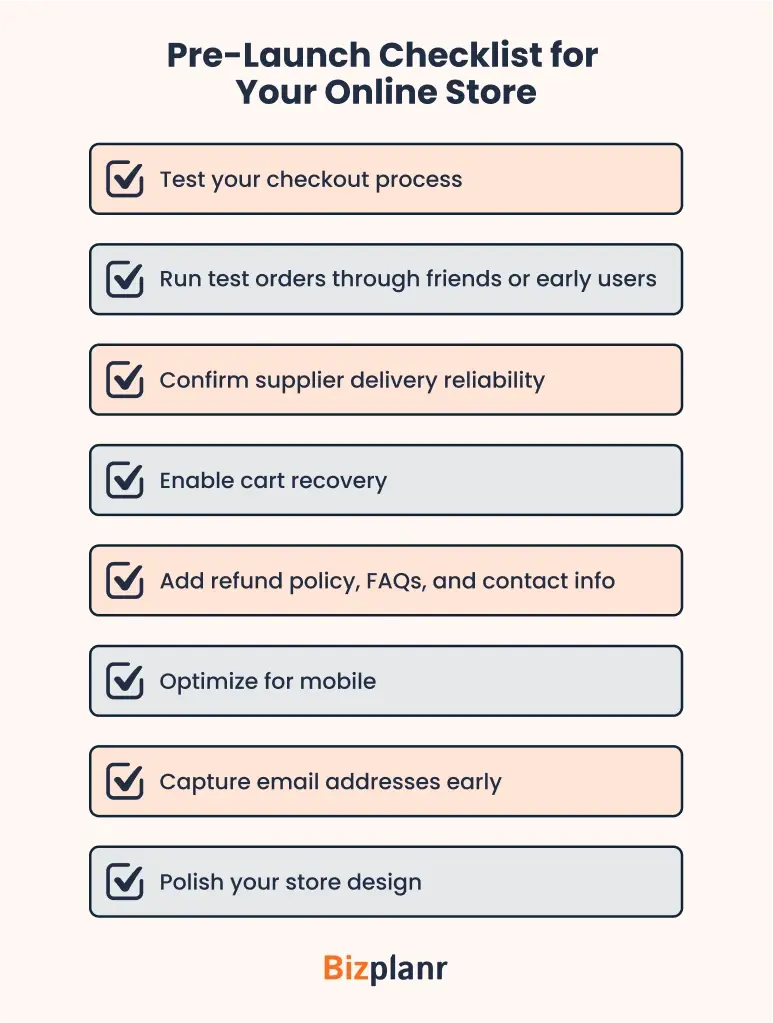Dropshipping appears simple: Pick trending products and launch ads. However, 80% of new stores fail within their first year because beginners skip crucial planning steps. They don't validate products, understand their numbers, or test suppliers properly.
This guide shows how to start a dropshipping business correctly, step by step. From selecting the right store model to building a trustworthy brand, we'll cover everything needed to succeed.
Let’s begin.
Key Takeaways
- Startup costs typically range from $300 to $1,600, depending on your niche, design, and first ad budget.
- Choosing the right store model (niche, general, or one-product) is important for your marketing and branding.
- Research and validation reduce wasted ad spend and help you find in-demand products that customers want.
- A clear business plan improves decision-making, budgeting, and your ability to scale or sell the store later.
Dropshipping is all about execution
Before jumping into dropshipping, it’s important to ask yourself one thing: Are you building a real business or just chasing a trend?
Many people get into dropshipping thinking it’s quick money. Rarely true. What makes it work is consistent execution. You don’t need to be a genius or have a background in business, but you do need to be serious about putting in the work.
Ask yourself, am I:
- Ready to spend 10–15 hours a week learning new skills? (That includes product research, ad testing, store design, etc.)
- Willing to fail a few times and learn from it without giving up?
- More focused on solving customer problems or just looking for products to go viral?
If your answer to most of these is “no,” it’s better to pause than waste time and money.
One of the biggest reasons dropshipping businesses fail is a lack of customer connection.
If all you’re doing is accepting orders from customers, then forwarding the order onto a supplier for them to fulfill, then you’re not going to create any sort of loyalty with the customer,” — Max Robinson, Fish Tank Bank
This quote highlights the importance of brand loyalty, even in a business like dropshipping. Without it, 90% of such businesses don’t survive (source: eCommerce Platforms, 2024).
Step 1: Choose your dropshipping store model: Niche, General, or One-Product
Before you even pick products, choose your store model. This decision shapes your branding, marketing, and long-term strategy. It’s not just about what you sell, it’s about how you sell it.
You generally have three options:
| Store Model | Pros | Cons |
|---|---|---|
| Niche Store |
|
|
| General Store |
|
|
| One-Product Store |
|
|
Which one’s right for your business?
- Beginners with a tight budget or less time → Start with a general store to test fast.
- Intermediate sellers who want more branding → Try a niche store.
- If you’ve already found a winning product → Go with a one-product store for sharp focus.
For example, you love fitness and only have weekends to work on your store. A niche fitness store could be perfect; it’s focused, easier to brand, and doesn’t need constant product research like a general store would.
Step 2: Research before you risk
Before spending money on products or ads, RESEARCH. It saves you from sinking money into something no one wants.
Here’s how to go about it.
1. Market size analysis
You need proof there’s demand. Use tools like Google Keyword Planner or Semrush to see how many people are searching for your product idea.
- Look for at least 1,000–5,000 monthly searches (this shows real interest).
- Watch out for keywords with extreme competition; if big brands dominate, it’s harder to stand out.
2. Profit margin calculation
Ensure the math works before you launch. Here’s a simple formula:
Profit Margin (%) = [(Selling Price - Total Costs) / Selling Price] × 100
Total Costs = COGS (cost of goods) + shipping + platform fees + ad spend
- Aim for at least 30–50% margins after all expenses [(source: Oberlo, 2023)].
3. Competition audit
Check out the top 3–5 competitors. Use SimilarWeb or manual website reviews.
- Note their pricing, shipping times, and marketing angles.
- Look for gaps you can fill, like better descriptions, faster shipping, or unique angles.
4. Demand Validation
Use these free tools to check real-world interest:
- Google Trends for seasonality and trending queries
- Amazon Best Seller Rank for what’s selling now
- TikTok/Instagram hashtags to spot viral potential
- Facebook Audience Insights to see who’s actually interested
If you want to make this process easier, Bizplanr offers templates and checklists to help you stay organized and avoid missing any important steps.
Step 3: Build a business plan
Let’s be honest, most new dropshippers skip this step and just wing it. That’s one of the fastest ways to burn cash and lose motivation.
70% of small business failures are linked to poor planning and management decisions.
Your goal isn’t to impress investors with a 40-page document. It’s to gain operational clarity so you know exactly what you’re doing. A good plan reduces guesswork, makes budgeting easier, and improves every decision you make.
So, what should your dropshipping business plan cover?
Think of it like a map for your journey:
- Value Proposition: What problem do you solve? Why should someone buy from you?
- Niche: Your chosen market and focus.
- Customer Persona: Who are you selling to? Age, interests, and pain points.
- Supplier Model: Which suppliers will you work with? How will you vet them?
- Fulfillment Method: How will orders be processed? Who ships them?
- Ad Channels: Where will you reach your audience? (Facebook Ads, TikTok, Google)
Without writing this down, you’re just guessing each step. That often means overspending on ads, choosing bad suppliers, or failing to connect with the right audience. (Yikes!)
Get Your Business Plan Ready In Minutes
Answer a few questions, and AI will generate a detailed business plan.
Step 4: Build a reliable supplier network
Your suppliers aren’t just order processors, they’re partners in delivering a good customer experience. A solid supplier network keeps your business running smoothly, even during spikes or disruptions.
First, understand your options.
| Platform | Fulfillment Speed | Quality Control | Communication |
|---|---|---|---|
| AliExpress | Slow (10-30 days) | Varies by seller | Often inconsistent |
| DSers | AliExpress aggregator | Same as AliExpress | DSers support adds help |
| CJ Dropshipping | Faster (7-15 days) | In-house QC | Better English support |
| Printful | Fast (2-7 days) | Strong QC, branding | Excellent, reliable |
After choosing the supplier, consider doing a due diligence, such as:
- Asking for a business license or verification
- Place a test order to check shipping speed
- Test communication (response under 24 hours)
- Order product samples to assess quality
If you sell high-volume SKUs, maintain 2–3 suppliers to avoid stockouts or sudden delays. This reduces risk if one supplier fails during peak periods.
Consider setting up a monthly review to monitor these areas:
- Defect rate – How many of your products have quality issues?
- Customer complaints – How often do customers report problems?
- Late deliveries – How frequently do orders arrive later than promised?
By checking these regularly, you can spot problems early and improve your service.
Over time, you can negotiate better terms as your order volume grows. Suppliers value reliable partners, so building strong communication and trust can lead to discounts, faster shipping, or priority handling.
Step 5: Set up the business infrastructure
A real business structure helps you separate personal and business finances, stay legal, and build trust with customers.
Sole Proprietorship vs. LLC — What’s the difference?
| Type | Pros | Cons |
|---|---|---|
| Sole Proprietorship | Easy, cheap to set up | No personal liability protection |
| LLC | Limits personal liability | Slightly higher cost and paperwork |
If you're just testing with a small e-commerce operation, a sole proprietorship might be enough to start. But an LLC is a good choice if you want personal asset protection and a more professional look.
Let's understand the basic legal setup.
- Register your business name: Check local requirements to ensure it’s unique.
- Get an EIN: An Employer Identification Number from the IRS helps with taxes and hiring.
- Open a business bank account: Keeps personal and business money separate.
- Collect sales tax: Register in states where it applies to avoid penalties.
Also, try exploring these optional but valuable additions:
- Business insurance: Protects you against liability claims or damaged goods. Makes sense if you plan to scale.
- Trademarks: Useful once your brand gains traction to protect your name and logo.
Step 6: Plan your finances
Don’t skip this. Even a lean business needs a rough plan for spending. Here’s how to think through the numbers before you launch.
1. Startup costs to expect
These are the basics to get off the ground. You can start scrappy, but there will be costs. Here's a quick breakdown:
| Item | Estimated Cost |
|---|---|
| Domain name | $12/year |
| Website theme/builder | $50–$200 one-time |
| Branding (logo/design) | $0–$300 |
| Product sample orders | $50–$250 |
| Email marketing tool | $20–$50/month |
| Initial ad budget | $200–$500 |
Expect at least $400–$1,200 in initial costs if you're going minimal. More if you hire help or go all-in on brand assets.
2. Ongoing monthly costs
These are the tools and spending you’ll likely have from month to month:
| Items | Monthly Estimates |
|---|---|
| Ecommerce platform (e.g., Shopify) | $29–$79 |
| Email software | $20–$50 |
| Ad budget | $300–$1,000 |
| Plug-ins/apps | $20–$100 |
| Misc. (freelancers, tools) | $50–$150 |
| Total (approx.) | $400–$1,500+ |
That’s about $400–$1,500/month, depending on how lean or loaded your setup is.
3. Give yourself a buffer
Things will cost more than you expect. Algorithms fluctuate. Sales take time. A safe bet is to have 3 months of operating expenses saved, plus a little extra for testing and pivots.
If you’re estimating $1,000/month, aim for at least $3,000–$4,000 in reserve before quitting your day job or going all in.
4. Key formulas to track
Start with these:
- CAC (Customer Acquisition Cost) = Total ad spend ÷ Number of new customers (If you spend $500 and get 25 customers, CAC = $20)
- AOV (Average Order Value) = Total revenue ÷ Number of orders (If you made $1,000 from 40 orders, AOV = $25)
- ROAS (Return on Ad Spend) = Revenue from ads ÷ Ad spend (If $1,500 revenue came from $500 in ads, ROAS = 3x)
These help you know if your marketing is working and if your pricing covers your costs.
Consider using Bizplanr to build a clear financial roadmap, which helps you avoid surprises and make informed decisions right from the start.
Step 7: Launch with a service mindset
Launching a store is more than just flipping a switch. Your first goal? Ensure everything works and makes customers feel they can trust you from the start.
Before running ads or announcing your store, test your entire order flow:
- Can users complete checkout smoothly?
- Do they receive order confirmation emails?
- Does the supplier fulfill the order quickly and accurately?
Ask a few friends or early users to place test orders and share their honest feedback on delivery time, packaging quality, and the updates they received by email or SMS. Use that real-world input to spot and fix any weak areas in your process before launching widely.
Next, focus on building trust right from the start. Ensure your website has a clean, mobile-friendly design. Include clear and helpful product descriptions with FAQs to answer common questions up front. Also, have an easy-to-find refund or return policy, along with visible contact information so customers can contact you.
Start email capture from day one. Use pop-ups or banners to collect emails and enable abandoned cart recovery. This helps you win back lost sales without spending more on ads.
Step 8: Set up for scale and exit
Once you’ve launched and smoothed out your operations, think about how you’ll grow.
Owning your story matters. Share why your store exists and who you’re here to serve. Great customer service builds loyalty: quick replies, clear policies, and friendly interactions.
Build a community through email lists, loyalty programs, or social media groups. And don’t underestimate memorable touches like branded packaging, inserts, or thoughtful unboxing experiences, even if you’re dropshipping.
Here are some transition options for your dropshipping business:
- Move from dropshipping to private label when you identify top-selling products.
- Create product bundles to increase average order value.
- Develop a custom line to own your supply chain and margins.
Don’t rely on a single sales channel. List on Amazon, Etsy, or social commerce platforms like Facebook Shops and Instagram checkout to spread risk and grow your audience.
If you want to sell your store later, ensure it runs smoothly without you. Standardize operations with clear SOPs, track profits monthly, and keep good supplier relationships.
You can also delegate tasks to virtual assistants to run things passively. For example, a pet niche store started with dropshipping, switched to private label, and sold for $50K in under three years thanks to solid branding and repeat customers.
Final thoughts
Starting a dropshipping business takes real planning, testing, and learning. Challenges like finding reliable suppliers, keeping customers happy, and managing your budget are normal.
The good news? You don’t have to solve everything at once. Break it down step by step to avoid common mistakes and build something sustainable. Tools like Bizplanr can help you stay organized and on track.
Keep focused, keep testing, and remember: every successful store began with that first sale.
Get Your Business Plan Ready In Minutes
Answer a few questions, and AI will generate a detailed business plan.
Frequently Asked Questions
Is dropshipping still profitable in 2025?
Yes, but it’s more competitive. Success comes from niche selection, great service, and smart marketing, not shortcuts or hype.
How much money do I need to start a dropshipping business?
Expect $300–800 for startup costs (domain, samples, ads) and at least 2–3 months of operating budget.
Do I need to register an LLC, or can I start as a sole proprietor?
You can start as a sole proprietor for simplicity, and later shift to an LLC, as it offers personal liability protection and a more professional image.
How do I choose a profitable niche or product?
Research demand with tools like Google Trends and Amazon Best Sellers Rank (BSR). Look for gaps competitors miss, and try offering something in between so the customer values it.
What tools do I need to launch and manage my dropshipping store?
You’ll just need a few basics to get started and run your store successfully:
- Ecommerce platform – to sell your products (e.g., Shopify, WooCommerce).
- Supplier apps – to source and import products (e.g., DSers, CJ Dropshipping).
- Marketing tools – for email campaigns and ads (e.g., Mailchimp, Facebook Ads).
- Analytics – to track sales and customer behavior (e.g., Google Analytics, platform reports).






